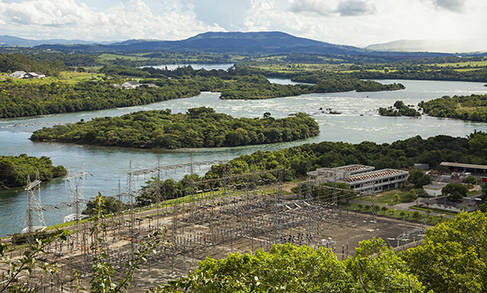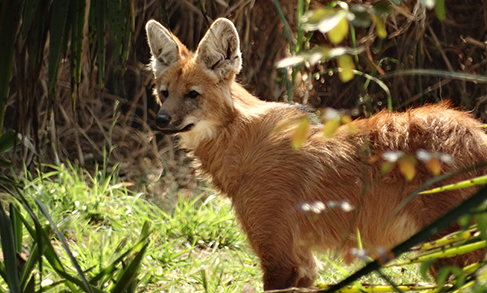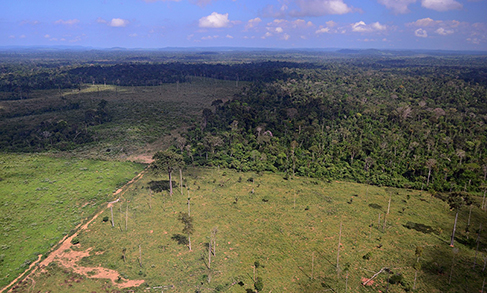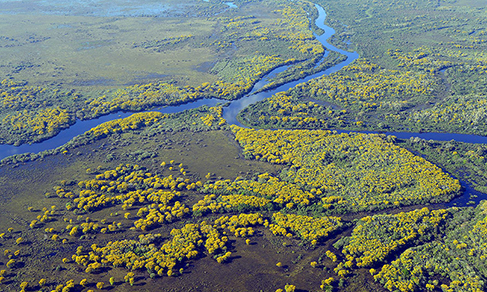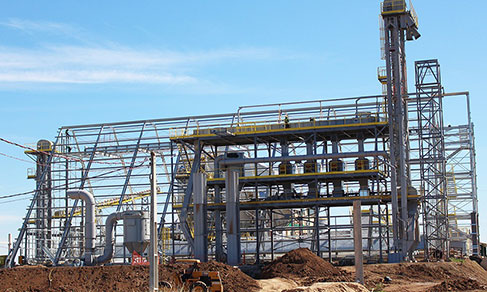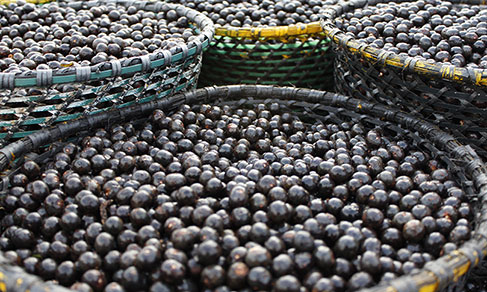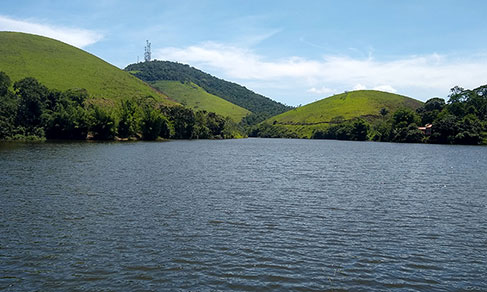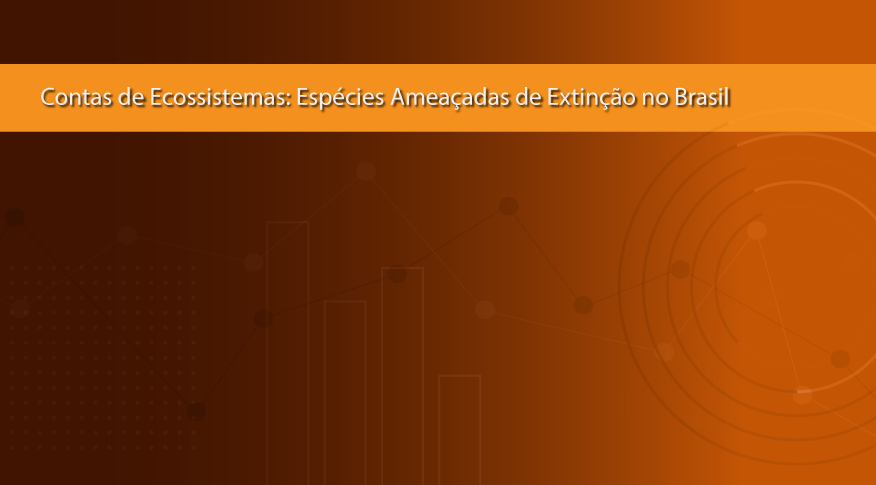Nossos serviços estão apresentando instabilidade no momento. Algumas informações podem não estar disponíveis.
Environmental-Economic Accounting
Description
The Environmental-Economic Accounting is a system of measurement and analysis, represented by a set of tables, which describes the interaction between the environment and the economy in order to give support to planning and decision making for public and business policies.
The methodology of economic and environmental accounting has been established by the United Nations through the System of Environmental-Economic Accounting - SEEA, in order to integrating economic, environmental and social data into a single statistical structure, considering also the characteristics of the country with regard to environmental, social and economic particularities and the availability of data. SEEA has eight thematic areas, including specific natural resources, such as water and energy, in addition to Ecosystem Accounting, among others. The proposed methodology for specific resource accounts is based on a central framework that accounts for the natural resources involved in the production of goods and services, establishing a relationship between the natural resources used and the income generated by different economic activities. In Brazil, the series of information on Environmental-Economic Accounting - CEA, results from a partnership between the IBGE and the National Water Agency - ANA. It began with the disclosure of results on the Environmental-Economic Accounting for Water - CEAA, covering the period from 2013 to 2015, based on the methodological recommendations in a specific manual for water: System of Environmental-Economic Accounting for Water, SEEA-Water. Ecosystem accounting, in turn, is based on the methodological recommendations contained in a specific manual: System of Environmental-Economic Accounting 2012: Experimental Ecosystem Accounting, SEEA-EEA, given the need to cross georeferenced spatial data. This methodology is being consolidated and tested by the United Nations, and the study is still called Experimental Ecosystem Accounting. The IBGE started the methodological tests for ecosystem accounting in 2017, from its participation in the Natural Capital Accounting and Valuation of Ecosystem Services (Ncaves) project - a United Nations global project, financed by the European Union which includes five countries (South Africa, Brazil, China, India and Mexico). The first results of the Ecosystem Accounting include Land Use in Brazilian Biomes, covering the period from 2000 to 2018, and the Endangered Species in Brazil, whose reference is 2014.
Currently, the accounts for water, energy, forests (wood and non-wood resources), biodiversity, ecosystem extent (ET) and ecosystem condition (EC) are being developed, tested and planned by the IBGE in partnership with specialized institutions. The geographic scope of these studies is national, with results published for different territorial sets.
About the publication - 2014 Species Threatened with Extinction in Brazil
Natural capital accounting is an accounting structure that allows measuring and comparing the contribution of natural resources and ecosystems to the social and economic aspects of a given territory over time. It can also provide dynamic and standardized statistics for planning and decision making, in order to promote more efficient and sustainable choices in the management of resources.
The IBGE puts out this publication recognizing the importance of integrating environmental data into the System of National Accounts - SCN, in order to consider the use of ecosystem services and to record how the use of the flow of these services by the economic system interferes with biodiversity assets. The results of the Threatened Species Account, elaborated within the scope of the System of Environmental Economic Accounting - SCEA, are presented in this study. This first version takes as reference the Red List of Threatened Species, of the International Union for Conservation of Nature (IUCN), known as the IUCN Red List of Threatened Species, for the species assessed in South America. Specifically for data analysis in Brazil, a compilation was made for the years 2010, 2014 and 2018 and the calculation of a simplified version of the Red List Index - ILV, the Red List Index - RLI, in different spatial and ecological scopes.
As a starting point for future editions, a synthesis of the data from the Official National Lists of Threatened Species of Fauna and Flora, resulting from the assessments of the conservation status of the species, published, respectively, by the Instituto Chico Mendes de Conservação da Biodiversidade (Chico Mendes Institute for Biodiversity Conservation- ICMBio) and the Centro Nacional de Conservação da Flora do Jardim Botânico do Rio de Janeiro (National Center for Plant Conservation of the Botanic Garden in Rio de Janeiro- CNCFlora/JBRJ). From these data, the numbers of species are presented, by categories, disaggregated for the different Brazilian biomes and the types of ecosystem realms (terrestrial, freshwater and marine). The publication also brings maps of the distribution of the threatened species in the National Territory.
The present study, also available on the IBGE website, contributes to the adoption of the international recommendations contained in the "System of Environmental-Economic Accounting 2012: Experimental Ecosystem Accounting", SEEA-EEA manual, developed by the United Nations within the scope of the Natural Capital Accounting and Valuation of Ecosystem Services - Ncaves), in partnership with the European Union.
The results presented here will hopefully be a starting point in the institutional arrangements necessary for an even greater integration of information on biodiversity in the decision-making processes, contributing, as a result, to the elaboration of other types of accounts and favoring the production of environmental statistics and indicators based on the best scientific knowledge available.
More on the product - 2014 Species Threatened with Extinction in Brazil
Publications
- Ecosystem Accounting: Species Threatened with Extinction in Brazil : 2014 (book)
- Ecosystem Accounting: Species Threatened with Extinction in Brazil : 2014 (brochure)
Tables from SIDRA system
Wall maps
Threatened fauna 2014 (pdf - in Portuguese)
Threatened freshwater fauna 2014 (pdf - in Portuguese)
Threatened marine fauna 2014 (pdf - in Portuguese)
Threatened terrestrial fauna 2014 (pdf - in Portuguese)
Threatened flora 2014 (pdf - in Portuguese)
Threatened freshwater fauna 2014 (pdf - in Portuguese)
Threatened marine flora 2014 (pdf - in Portuguese)
Threatened terrestrial flora 2014 (pdf - in Portuguese)
Vectors
Threatened fauna 2014 (shp - zipped - in Portuguese)
Threatened freshwater fauna 2014 (shp - zipped - in Portuguese)
Threatened marine fauna 2014 (shp - zipped - in Portuguese)
Threatened terrestrial fauna 2014 (shp - zipped - in Portuguese)
Threatened flora 2014 (shp - zipped - in Portuguese)
Threatened freshwater fauna 2014 (shp - zipped - in Portuguese)
Threatened marine flora 2014 (shp - zipped - in Portuguese)
Threatened terrestrial flora 2014 (shp - zipped - in Portuguese)
Tables
Species of fauna and flora, by conservation status, according to the groups of species and considered disaggregation (xlsx | ods)
Species of fauna and flora, by conservation status, according to the realm type and considered disaggregation (xlsx | ods)
Complementary table - Occurrences in disaggregations and associations with realms for species of flora and fauna (xlsx | ods)
Publications - 2014 Species Threatened with Extinction in Brazil
Ecosystem accounts : species threatened with extinction in Brazil : 2014 / IBGE, Department of Natural Resources and Environmental Studies, Department of National Accounts
Material type: Book
Year: 2021Contas de ecossistemas : espécies ameaçadas de extinção no Brasil : 2014 / IBGE, Coordenação de Recursos Naturais e Estudos Ambientais, Coordenação de Contas Nacionais
Material type: Book
Year: 2020
Learn more - 2014 Species Threatened with Extinction in Brazil
Downloads
News and Releases
Environmental-Economic Accounting for Water: Brazil
In 2020, Brazil consumes 6.2 liters of water for each R$1 generated by the Economy
In 2020, 6.2 liters of water were consumed for each real of gross value added (GVA) generated by the...
02/06/2023
Ecosystem Accounting
IBGE updates statistics on threatened species in Brazilian biomes
The IBGE released today (24) the updated data on threatened species for year 2022. This set of information...
24/05/2023
Ecosystem AccountingEnvironmental-Economic Accounting for Land
Between 2000 and 2020, agricultural area grew 230 thousand km², natural vegetation reduced 513 thousand km² in Brazil
The IBGE released today (7) the Environmental-Economic Accounting for Land: Physical Accountability,...
07/10/2022
Ecosystem Accounting
In partnership with the UN, IBGE releases integrated analysis of Ecosystem Accounts
The IBGE releases today (20) “Ecosystem Accounts: results of the NCAVES project in Brazil ”, which compiles...
20/05/2022
Environmental-Economic Accounts for Energy: products from biomass
In 2018, Brazil generated R$84 billion in energy products from biomass
In 2018, the national production of natural energy inputs from biomass was 91.3 million tonnes of oil...
09/12/2021
Environmental-Economic Accounts for Energy: products from biomass
Biomass products represented 9% of electricity in Brazil in 2018
In 2018, the production of electricity from energy products from biomass was of 54.4 thousand gigawatt-hour...
09/12/2021
Ecosystem Accounting
Experimental study estimates value of water bodies during abstraction, treatment and distribution of water
The IBGE has released today (28) Ecosystem Accounting: Value of the Ecosystem Service of Blue Water Provisioning...
28/04/2021
Ecosystem Accounting
Experimental study analyzes amount and value of non-wood forest products per biome
The IBGE has released today (15) the Ecosystem Accounts: Non-Wood Forest Products, experimental statistics...
15/04/2021
Environmental-Economic Accounting for Water: Brazil
Experimental study evaluates water conditions in Brazilian biomes
The IBGE has released today (15) Ecosystem Accounting: Condition of Water Bodies, experimental statistics...
15/04/2021
Ecosystem Accounting
In 2014, Atlantic Forest/Mata Atlântica was the biome with the highest number of species threatened with extinction
The survey “Ecosystem Accounting: Species Threatened with Extinction in Brazil”, which the IBGE releases...
05/11/2020
Errata
Correction in the publication “Ecosystem Accounting: Valuation of the ecosystem service of blue water provision 2013-2017”
Published date: 04/05/2021
Description:
Two typing errors were identified on page 26, in the title for Graph 7 and in the first paragraph, in the unit of measurement adopted in both of the cases.Actions: The file has been replaced.
Amendment in “Ecosystem accounts: land use in Brazilian biomes 2000-2018” publication
Published date: 16/10/2020
Description:
An error was pinpointed by the IBGE in the percentage data of the main conversion of land use in the Pantanal Biome. Due to a typing error, the percentage reported in the publication does not involve that in the survey´s databases.Actions: The text in the publication was changed to report the correct percentage.
Error in the release date of the publication "Ecosystem Accounting: Species Threatened with Extinction in Brazil 2014"
Published date: 02/10/2020
Description:
The IBGE identified an error for the non-compliance with the release date of the publication Ecosystem Accounts: Species Threatened with Extinction in Brazil 2014, expected to be released in October according to the calendar of geoscientific products available on the portal. Due to the COVID-19 pandemic, the release was postponed until November 05, 2020.Actions: The release calendar was changed.
Error in the release date of the publication "Ecosystem Accounting: Biodiversity and Species Threatened with Extinction, version 2014"
Published date: 28/09/2020
Description:
Error, identified by the IBGE, of non-compliance with the release date of the publication Ecosystem Accounting: Biodiversity and Biodiversity and Species Threatened with Extinction, version 2014, scheduled for September in the geoscientific products calendar on the IBGE web site. Due to the COVID-19 pandemic, its disclosure was postponed until October 16, 2020.Actions: The release date was rescheduled.
Links
Our websites:
SIDRA | Statistical Tables Database
Methodological manuals:
Manual of the System of Environmental-Economic Accoutning- Central Framework (UN)
Manual of the System of Environmental-Economic Accounting - Experimental Ecosystem Accounting (UN)
Other publications:
Ecosystems Accounts: Results of NCAVES Project in Brazil
Water Use in Rainfed Agriculture
International classification of ecosystems in Brazil
Other links:
Natural Capital Accounting and Valuation of Ecosystem Services (UN)




